Nepal, situated in the heart of the Himalayas, is known for its natural beauty, but not just that; it also has a culture that has been passed down for generations. It is what our ancestors took pride in, and it’s being reflected on monuments in Nepal all over the country. From the UNESCO World Heritage Monuments to the ancient temples and palace complexes, such monuments in Nepal are a testament to the country’s architectural genius, religious tolerance, and royal heritage. Find out about several of Nepal’s most prominent and esteemed monuments, which continue to captivate and inspire visitors from across the globe.
Top 12 Monuments In Nepal
Below is a list of monuments in Nepal, from ancient stupas to royal palaces. Every monument connects to the timeless tapestry of Nepal’s history.
1. Swayambhunath Stupa (Monkey Temple)
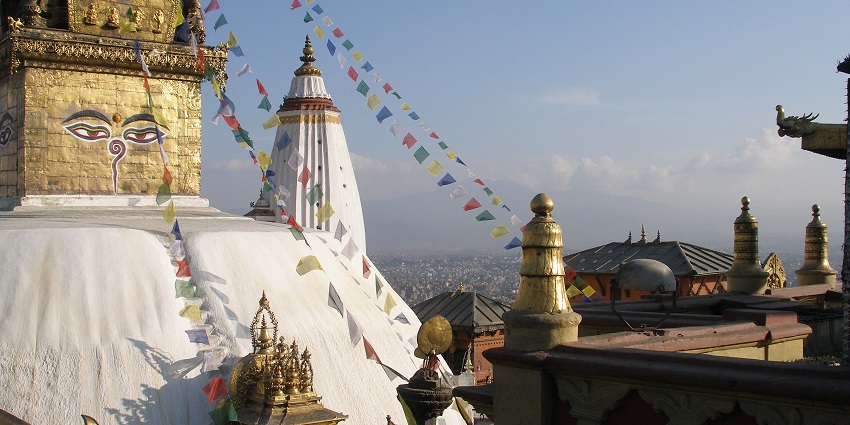
Photo: Vyacheslav Argenberg / Wikimedia Commons
The Swayambhunath Stupa (Monkey Temple) is a place of veneration and reverence for Nepalese and travelling Buddhists and Hindus. It is a hilltop stupa that is believed to be over 2,500 years old and is a UNESCO World Heritage site. The main white dome of the stupa represents the world, the gilded spire above symbolises enlightenment, and the Buddha’s all-seeing (the all-knowing) eyes are represented in all four directions of the spire. It often serves as the symbol of Nepalese Buddhism. There are many smaller shrines, statues, and fluttering prayer flags among the smaller shrines that surround the hilltop stupa.
Entry Fee: NPR 200 / ₹125
2. Boudhanath Stupa
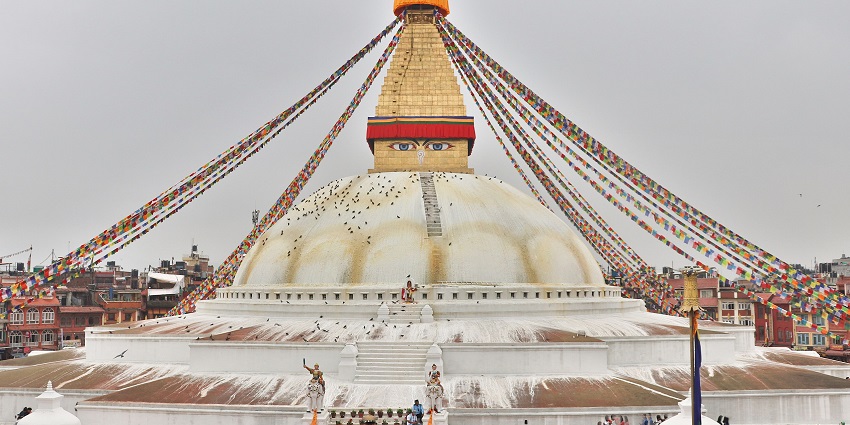
Photo: Nabin K. Sapkota / Wikimedia Commons
Boudhanath Stupa is among the largest and most sacred stupas in the world and is located approximately 11 kilometres from the centre of Kathmandu. Boudhanath Stupa stands 36 metres high and is a prominent pilgrimage destination for those following Tibetan Buddhism. Boudhanath is protected and maintained as a UNESCO World Heritage Site and stands as a huge mandala (a sacred diagram) base, a white dome (representing purity) and a gold-plated spire standing on top containing the all-seeing eyes of Buddha. Upon arrival, you will see the stupa encircled with 108 small images of Dhyani Buddha (the state of enlightenment) and prayer wheels.
Entry Fee: NPR 400 / ₹250
3. Pashupatinath Temple Complex
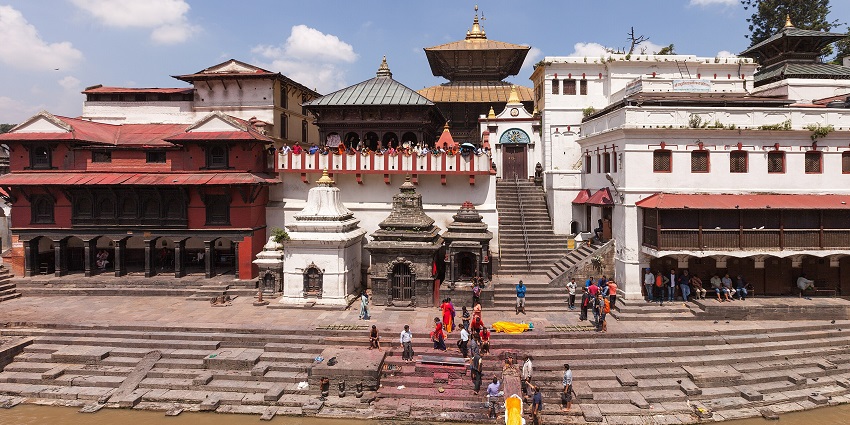
Photo: Bijay Chaurasia / Wikimedia Commons
Pashupatinath Temple is among the most revered Hindu temples and a spiritual icon among Nepal’s greatest monuments. Located on the banks of the Bagmati River in Kathmandu, this World Heritage site by UNESCO is devoted to Lord Shiva and attracts thousands of pilgrims, particularly during the Maha Shivaratri festival. The principal temple has a beautiful pagoda roof and gilded and intricately carved wooden rafters. Non-Hindus cannot enter the central sanctum, but the precinct has much to see, including ancient temples, cremation ghats, and ashrams.
Entry Fee: NPR 1,000 / ₹625
4. Kathmandu Durbar Square
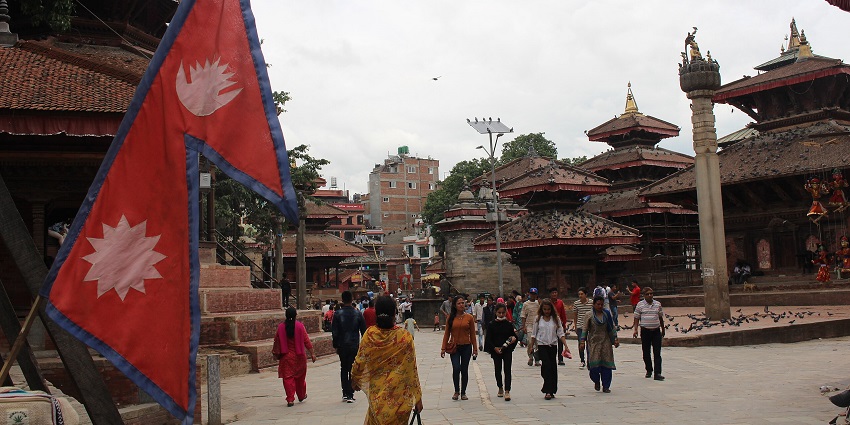
Photo: Jayen Shrestha / Wikimedia Commons
Kathmandu Durbar Square, situated in Kathmandu, is a historic palace complex and a significant monument in Nepal. The square was formerly the royal palace of the Malla kings and the Shah kings. It is a lively and vivid sample of Newari architecture, as evidenced by the intricately carved wooden windows, courtyards, temples and the Hanuman Dhoka Palace. Some of the prime attractions are the Taleju Temple, Kumari Ghar or the Living Goddess’s residence, and the Kal Bhairav statue. The square is a UNESCO World Heritage Site and is still a cultural centre, celebrating festivals such as Indra Jatra and Dashain.
Entry Fee: NPR 1,000 / ₹625
5. Patan Durbar Square

Photo: Bijay Chaurasia / Wikimedia Commons
Patan Durbar Square, located in the centre of Lalitpur, is a UNESCO World Heritage Site, containing traditional Newari architecture with intricately carved wooden windows, old temples, and statues. There are several significant structures in the square, including the Krishna Mandir, Bhimsen Temple, and the Hiranya Varna Mahavihar (Golden Temple), and it was once the royal palace of the Malla kings. Patan Museum, within the royal palace, gives profound insight into Nepal’s arts and cultural history. Certainly, Patan Durbar Square is the most important single monument in Nepal and light years ahead of other sites in the country.
Entry Fee: NPR 1,000 / ₹625
6. Bhaktapur Durbar Square
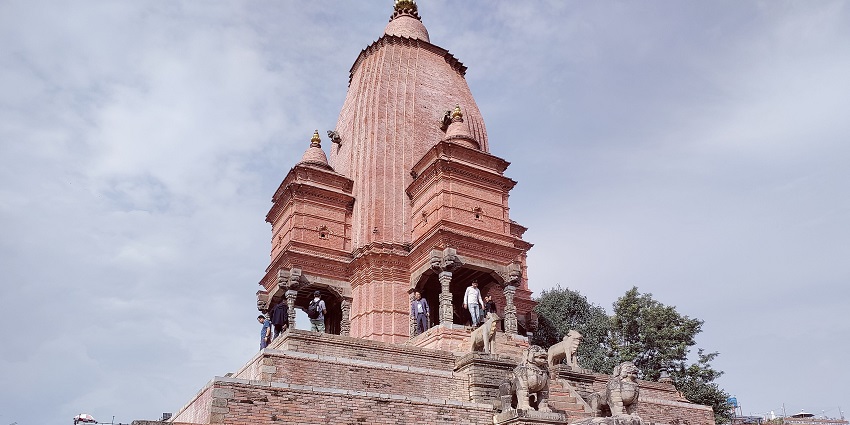
Photo: Janak Bhatta / Wikimedia Commons
Bhaktapur Durbar Square is situated in the old town of Bhaktapur. This square is an elaborate representation of Newari architecture and art. It has a set of gorgeous palaces, courtyards and temples, such as the famous 55-Window Palace and Vatsala temple. The square is a repository of the cultural and religious history of the Malla rulers who dominated Kathmandu Valley. Visitors can see highly detailed woodcarvings, stone carvings and the iconic pagoda roofs. As an official UNESCO World Heritage Site, Bhaktapur Durbar Square has visitors interested in the first-person experience of Nepal’s artistic representation, and there are plenty of other local and international tourists..
Entry Fee: NPR 1,500 / ₹940
7. Changu Narayan Temple (UNESCO World Heritage Monument)
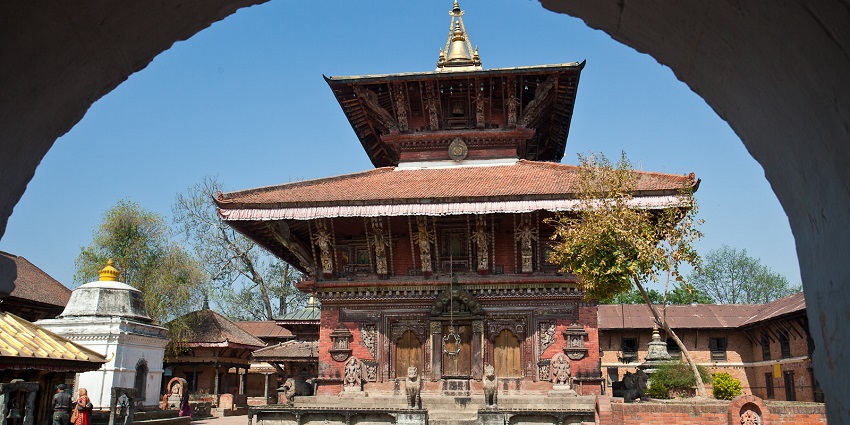
Photo: Greg Willis / Wikimedia Commons
One of the oldest and historically important monuments in Nepal is Changu Narayan Temple, situated on a hilltop close to Bhaktapur. This is an ancient temple (dating to the 4th Century) of Lord Vishnu at a UNESCO World Heritage site, representing the finest traditional Nepali architecture. The temple is constructed in a two-tiered pagoda form, and it’s perfectly embellished with wood and stone sculptures that carve gods, non-secular symbols, and mythological animals. Nestled in a beautiful redan-roc (lush green vegetation and tranquil village), the temple is both a spiritual hub and a cultural gem.
Entry Fee: NPR 300 / ₹190
8. Guhyeshwari Temple

Photo: Rajesh Dhungana / Wikimedia Commons
One of the major Shaktipeeths in Hinduism is the Guhyeshwari Temple by Bagmati, which is the sacred river in Kathmandu. It is a temple to Goddess Parvati, representing the place where it is believed that her yoni (the organ) fell, symbolising power and feminine creation. Originally constructed during the 17th century by King Pratap Malla, the temple has traditional pagoda architecture, ornately carved wooden ceilings and a golden roof. During Dashain and Navaratri, plenty of devotees go there to get its divine blessings, which play a central role in the temple.
Entry Fee: NPR 200 / ₹125
9. Kopan Monastery
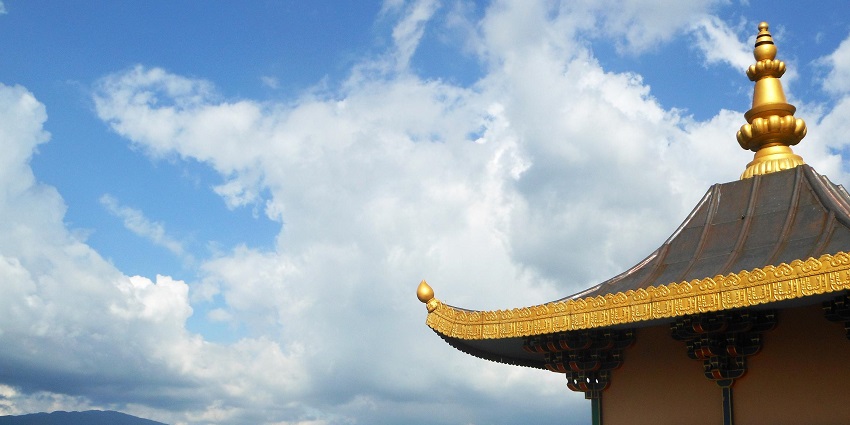
Photo: Aleksandr Rain / Wikimedia Commons
Kopan Monastery is one of those rare places founded in the east; it was founded by Lama Thubten Yeshe and Lama Zopa Rinpoche in 1969. Kopan Monastery operates as a Tibetan Mahayana Buddhist centre where one can learn about meditation and study the religion. The monastery operates month-long meditation courses which attract people from all over the world. Kopan Monastery is home to over 300 monks. The monastery has a glorious main temple with brilliant murals, statues, and colourful Tibetan architecture. As one of the lesser-known spiritual monuments in Nepal that provides a place for a majority of Buddhist teachings.
Entry Fee: N/A
10. Kailashnath Mahadev Statue
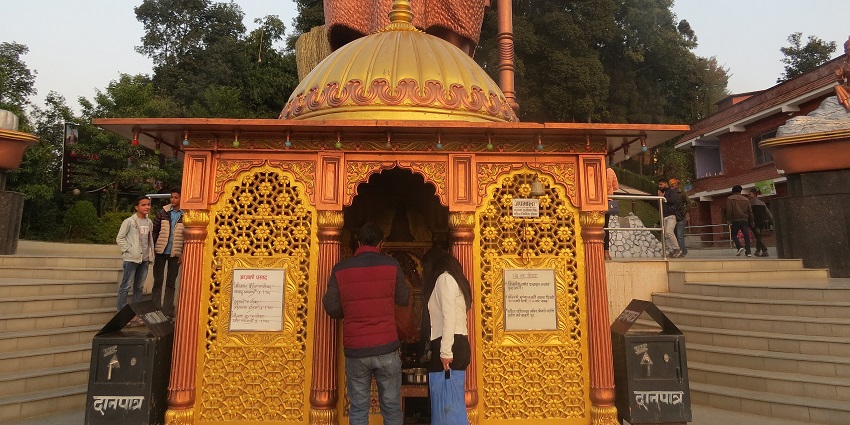
Photo: Harry Paudyal / Wikimedia Commons
The world’s tallest statue of Lord Shiva, the Kailashnath Mahadev Statue, is 143 feet (43.5 m) tall. Located in Sanga on the Nepal-India border between Bhaktapur and Kavrepalanchok District, this modern religious architecture is an icon you cannot miss. A copper, zinc, concrete and steel statue of the Lord in deep meditation to represent relaxation & soul power. It has become one of the holiest pilgrimage destinations as well as a prominent tourist spot after it was completed in 2010. The statue sits high up amidst beautifully allotted hills and valleys; it has an aura of its own, not with crowds surrounding it.
Entry Fee: NPR 640 / ₹400
11. Hanuman Dhoka Palace Complex
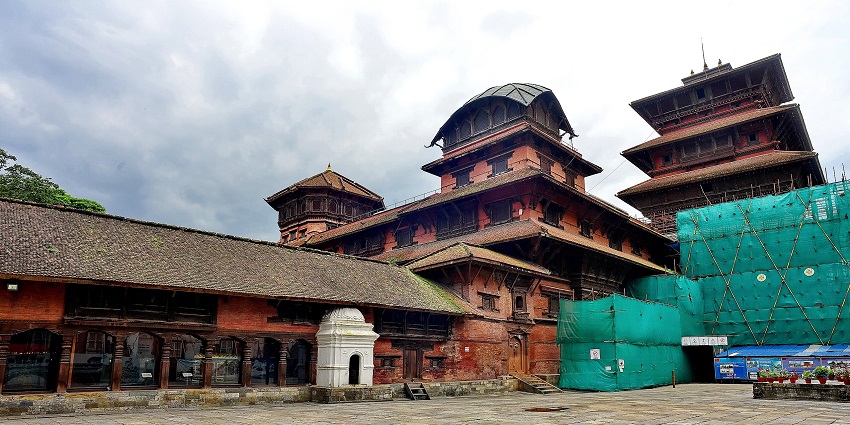
Photo: Rajesh Dhungana / Wikimedia Commons
Hanuman Dhoka Palace Complex is a historic royal palace in the centre of Kathmandu Durbar Square, a UNESCO World Heritage Site. It was the Malla kings’ and, subsequently, the Shah dynasty’s royal residence up to the 19th century. The complex is named “Hanuman Dhoka” after the stone image of Lord Hanuman near the central entrance, dated 1672. The five-acre complex comprises traditional Newari architecture with intricately carved wooden windows, temples, and courtyards. Among its most significant structures are the Nasal Chowk, Basantapur Tower, and the Taleju Temple.
Entry Fee: NPR 1,000 / ₹625
12. Janaki Mandir
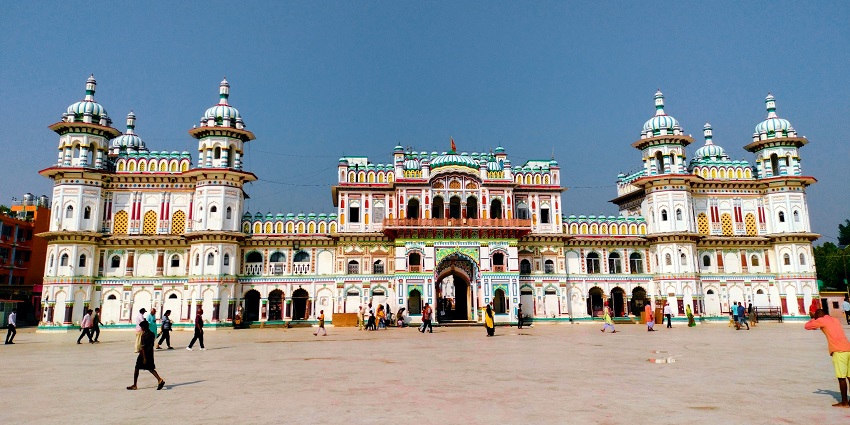
Photo: Suyash.dwivedi / Wikimedia Commons
Janaki Mandir is a beautiful white marble temple located in Janakpur, Nepal, dedicated to goddess Sita (Janaki), who was the wife of Lord Rama and was built in 1910 by Queen Vrisha Bhanu of Tikamgarh. With a rich history in this city. Architecturally, it is an exquisite and unique structure that blends Mughal and Koiri styles. The temple is located on the same site as the birthplace of Sita, where she married Lord Rama. It has all the dramatic white façades and domes, and a variety of beautiful scenes and colours that inspire thousands of pilgrims and tourists each year.
Officially recognised monuments in Nepal are not only markers of historical depth and architectural beauty but also serve the purpose of representing a perennial touchstone for spirituality and culture. Visitors can experience everything from the great stupas in Kathmandu to the royal durbar squares and temples that are all part of the monuments and all manifestations of remarkable artistry and significance. Plan a trip with TripXL today.
Cover Photo: Abhishek Dutta / Wikimedia Commons


 WhatsApp
WhatsApp
 Twitter
Twitter









